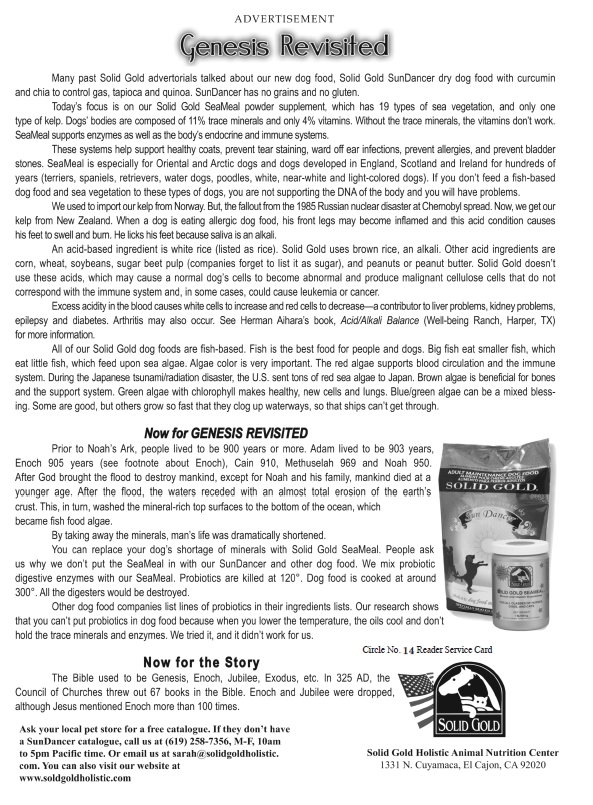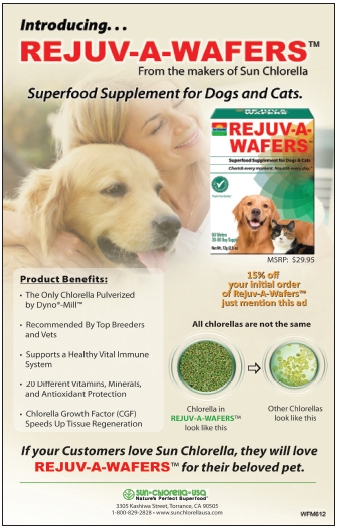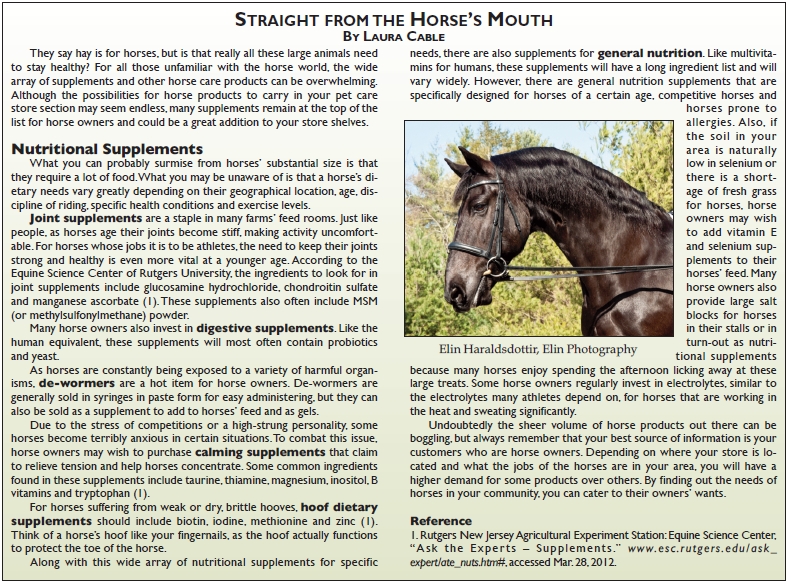Taking care of household pets is a lot like taking care of small children, in that they simply cannot do it for themselves. Domesticated animals have had many of their instincts and much of their responsibility for their own survival replaced with the loving care of their owners. This, of course, means that their human caretakers must go the extra mile if these animals are to be as healthy as they can be, and good pet owners understand this.
The majority of pet owners seem ready and willing to make the effort for their pets. Packaged Facts reports that 90% of cat owners and 92% of dog owners consider their pet a part of the family, and this means a greater willingness to spend a lot of money on their pets’ wellbeing, especially in households where pets are the focus (1). “Pet parents without children in the household are less likely to balk at higher-priced pet products and services—particularly those positioned squarely on health, as well as on other premium appeals including pampering, safety and convenience,” says the marketing firm.
The report also reflects the increasing number of Latino households entering into pet ownership, and the large role that high-income pet owners play in carrying the pet care market. With these demographics in mind, we’ll take a look at pet health basics, as well as tackling some information on horses and their health needs that may help you cater to your equestrian clientele. As we’ll find out in detail, wholesome, natural nutrition, fortified foods and specialized pet supplements will all help owners to keep Fido feisty and Kitty kickin’.
Pet Health 101
Pets may be part of the family, but they are not just like us. In fact, it is important to recognize that one size does not fit all in the pet health category. “We understand that pets are biologically different—and not just from humans, but unique within their own species and even breeds. At the same time, we  recognize similarities, like the capacity for stress, that affect all animals,” says Karin Krisher, copywriter for Pet Naturals and FoodScience of Vermont, Essex Junction, VT. Alleviating stress and the issues it causes is one of the many facets of wellbeing that can be addressed by pet care products. As experts will attest, the foundation for that wellbeing is a proper diet.
recognize similarities, like the capacity for stress, that affect all animals,” says Karin Krisher, copywriter for Pet Naturals and FoodScience of Vermont, Essex Junction, VT. Alleviating stress and the issues it causes is one of the many facets of wellbeing that can be addressed by pet care products. As experts will attest, the foundation for that wellbeing is a proper diet.
Wholesome foods and nutrition. Though we humans often have trouble taking our own dietary advice, pet owners can at least make sure that the animals in their lives get a healthful, well-rounded balance of foods to eat. Many natural manufacturers also emphasize the value of pet foods that are free of unnecessary or unnatural ingredients.
By providing a combination of high-quality natural food, supplements and healthy treats, owners can guide their pets to optimal health, claims Donna Spector, DVM, DACVIM, veterinary advisor for Halo, Purely for Pets, Tampa, FL. It’s also a matter of suiting individual needs, something with whia veterinarian can help pet owners. “Selecting the right food can help eliminate problems with allergies, intestinal problems, obesity, diabetes and other food-related diseases,” she says.
Foods for common household pets, Spector argues, should contain whole meat, vegetables and grains to ensure the best nutrition from natural ingredients. Her company makes a point of avoiding artificial colors, flavors and preservatives, and steers clear of chicken meal and other rendered meats.“Halo encourages pet owners to critically evaluate the labels of all products they are using and to read and understand all ingredients,” she says.
Concurring is Patrick Meiering, founder and CEO of Zuke’s, Durango, CO, whose policy is that the ingredient lists on pet treats should read less like laboratory inventory sheets and more like nutritionists’ checklists, full of recognizable, healthful food from the garden. Saying that it matters what we put in our bodies, and that the same goes for dogs and cats, Meiering notes that his company selects high-quality meats and premium grains, fruits, vegetables and oils for its products. They also keep products free of preservatives like butylated hydroxyanisole (BHA), added animal fat and other by-products. Many companies, including Meiering’s, strive to keep their foods free of content like corn, wheat and soy for allergy and other potential health reasons. Sissy Harrington-McGill, founder of Solid Gold Health Products for Pets, El Cajon, CA, says her company’s products are free of those three ingredients due to the potential for allergic reactions in dogs and cats.
One mistake pet owners can make when dealing with popular pet food brands is presuming they present a balanced diet, without need of additional nutritional support, according to Guinevere C. Lynn, MBA, director of business development at Sun Chlorella USA, Torrance, CA. Says Lynn, “I think that this type of thinking could be potentially dangerous and lead to malnutrition. Pet supplements work as a perfect adjunct to your animal’s diet—just like for humans.”
Health by addition. There are, of course, pet foods that present a healthy basis for an animal’s day-to-day nutrition. “Unfortunately, commercial pet foods oftentimes do not nutritionally provide everything that is needed,” Lynn says. This is where supplements and fortified foods come in, and Lynn says studies have shown that supplementing pet diets with antioxidants like omega-3 essential fatty acids, probiotics and prebiotics for maintaining bacterial balance, as well as vitamins and minerals is important to maintaining health.
 Antioxidants play the same role in our four-legged companions that they do in us. “Similar to human cells, canine cells produce damaging free radicals as a by-product of oxygen use and these damaging free radicals can lead to diseases and other serious health conditions,” says Meiering. His company’s treats are packed with antioxidant-rich superfoods to help reduce the risks of these conditions. Antioxidants also, he points out, help mitigate pain associated with inflammation.
Antioxidants play the same role in our four-legged companions that they do in us. “Similar to human cells, canine cells produce damaging free radicals as a by-product of oxygen use and these damaging free radicals can lead to diseases and other serious health conditions,” says Meiering. His company’s treats are packed with antioxidant-rich superfoods to help reduce the risks of these conditions. Antioxidants also, he points out, help mitigate pain associated with inflammation.
Even supplements still catching on with human consumers can make their way into pet food. Harrington-McGill cites her firm’s use of krill oil in cat food, for instance. Superfruits and berries can also be a healthy inclusion for their antioxidant properties and other unique benefits. “We were the first ones to put blueberries and cranberries in dog food; this is for urinary tract infections, and also for the omega-3s,” says Harrington-McGill.
The nutrient-dense micro-algae chlorella, with its natural stores of chlorophyll, fiber, mixed carotenoids and nucleic acids, represents a highly nutritious diet option for cats and dogs, according to Lynn. To her company’s chlorella, sold in the form of wafers for pets, lecithin has been added to benefit the skin and coat, as well as eleuthero for stress and endurance.
The digestive side of things is of great importance in pets such as dogs, which need to maintain a delicate gastrointestinal balance to stay healthy. “Every mammal’s intestinal tract contains a variety of beneficial microflora that assist with the proper function of the digestive system. Short-chain fructooligosaccharides (scFOS), otherwise known as prebiotics, work by acting as a food source for these beneficial intestinal flora,” says Santiago Vega, senior manager of nutrition at Corn Products International/National Starch Food Innovation, Bridgewater, NJ.
Mono-gastric (single-chambered stomach) mammals, from humans to cats and dogs, don’t digest scFOS efficiently. This is how they can proceed to the large intestine for use as an energy source by beneficial bacteria, from Bifidobacteria to Lactobacilli, Vega explains. These bacteria constitute an important arm of the immune system, just as in humans. Vega’s company supplies a prebiotic ingredient (FortiFeed) derived from either cane or beet sugar, which uses non-GMO ingredients and a natural enzymatic fermentation method. Certain whole foods, meanwhile, can assist with a pet’s digestion. Harrington-McGill says digestive health was a focus in the development of her company’s products, so, “We added chia seeds and quinoa, which reduce gas.”
As mentioned, anything that can help calm an anxious pet or bring an animal emotional balance will be a boon for their health. “When pets are anxious or upset, diet, sleep patterns and actions toward others can change, causing an overall effect on health that, if left unchecked, can be permanently detrimental,” says Krisher. Her company offers calming pet food formulas designed to combat environmental stressors and to balance mood. This can, in turn, alleviate behavior problems associated with stress, without causing drowsiness. Of stress in general, Krisher says, “Many people overlook this aspect of their pets’ health, without understanding just how far-reaching the effects of that neglect can be.”
|
Pet Products Galore The following items are available from the pet health companies interviewed in this article. Halo, Purely for Pets: Natural pet food, healthful treats, natural herbal eye and ear washes, natural grooming products, Dream Coat essential fatty acid supplement, Vitamin Mineral Mix, Daily Greens supplement, glucosamine-chondroitin, Vitamin C. National Starch Food Innovation: FortiFeed (fructooligosaccharide prebiotic ingredient). Pet Naturals/FoodScience of Vermont: Daily Best vitamins, Scoot Bars, Breath Bars, Agility DMG. Solid Gold Health Products: Sun Dancer (curcumin dog food), high-protein dog and cat foods, SeaMeal, vitamins and other supplements. Sun Chlorella USA: REJUV-A-WAFERS (chlorella pet wafers). Zuke’s: Zuke’s Z-Bones (dental care), Zuke’s Hip Action, Zuke’s Superfood treats. |
Something to keep an eye on when recommending pet products is the importance of compliance, or the acceptance of a supplement or food by the pet. Kirsher believes that compliance and palatability are important when assessing a product.
Unlike humans, it might not be readily obvious that a pet health product is working, since they can’t exactly give us a report about how they feel. Therefore, Kirsher also emphasizes that pet products need to be efficacious. She states, “We don’t create treats with empty calories and wait for a placebo effect—we create well-researched supplements meant to support overall health, and watch as these change the lives of the pets around us for the better.”
Lithe and limber. If the pet care market has a well-developed subdivision, it may be that of joint health. There are many ingredients and products in various forms that seek to alleviate stiffness and immobility (whether these are due to disease or age), as well as to prevent these conditions from setting in. Some of these products are homeopathic blends, and one pet joint formula uses ingredients including marine collagen extract, boswellia extract and corydalis root (2). Then there are glucosamine and chondroitin, about which a 2007 trial published in The Veterinary Journal found that after 70 days of treatment, dogs treated with the two supplements showed a decrease in pain and an increase in mobility (3).
Meiering explains that his company’s joint health formula, in addition to glucosamine and chondroitin, now also contains an eggshell membrane ingredient along with an anti-inflammatory enzyme proven to reduce joint stiffness. It will also include the likes of turmeric, sage and rosemary, herbal ingredients known for their antioxidant benefits in humans. Harrington-McGill notes that her firm’s biggest seller is a curcumin-infused dog food, which she says can have additional benefits, including for obesity, the liver and for irritable bowel syndrome.
Navigating Pet Ownership
We’ve gone over some of the whats in the pet health sphere, so now it’s on to some of the hows and whys. These tips will translate into a more vigorous life for your customer’s pets. Spector, for starters, wants to emphasize why supplements make as much sense for pets as they do for humans. “Not only do supplements act as an insurance policy that pets are getting all nutrients they require each day, they can also help to counter the aging process,” she says, adding that omega-3 fatty acids and a vitamin/mineral supplement are a good place to start.
This is especially important when pets are primarily eating food that’s been denatured of its health value. “During the cooking process of foods, some of the essential nutrients can be lost, so it’s a good idea to supplement your pet’s diet with a good vitamin and mineral supplement,” along with trying to incorporate more nutrient-dense foods, says Lynn.
Digestive and dental health are at the forefront for Krisher as areas to keep a special eye on with house pets, as she says the far-reaching effects of illness in either case are too serious to ignore. Periodontal disease is a problem in both cats and dogs, and can lead to further problems from cardiovascular disease to the improper absorption of nutrients, according to Krisher. “In the digestive health area, the same is true: any issue of the digestive system affects other systems, like neurological health and immune system health. In this category, diet plays a huge role,” she says, noting that this is the reason behind the probiotics and enzymes included in her company’s pet food line—to support nutrient absorption and utilization.
For oral hygiene and dental health, Meiering suggests a natural alternative to both manual tooth brushing for pets and to paying for intrusive procedures by the vet that require sedatives just to clean teeth. Dog bones or chews like those on offer from his company can be used on a daily or weekly basis to clean teeth and freshen breath.
As caretakers, pet owners often err by “over-treating,” Spector explains. “Obesity is a major health risk to dogs and cats and it is currently estimated that over 50% of U.S. pets are overweight or obese. Obesity contributes to medical conditions such as diabetes, arthritis, heart and lung disease, high blood pressure and compromised immune function.”
The solution, in addition to cutting down on fattening treat consumption, is simple—keep them active! Though this type of advice won’t sell products, your pet-owning customers will appreciate the reminder. “Walking your dog or playing with your cat is a great way to stimulate both of your needs for attention and movement, and to stay healthy all around,” says Krisher. Meiering adds, “Pet exercise is heavily overlooked, and often neglected. Getting active with your pet could be a simple stroll in the park, or hitting your favorite trail for a hike.” There are also natural pet food formulas available that are designed to keep weight down.
Safe, and Sound
Pet food safety scares are unfortunately a commonplace occurrence. The American Veterinary Medical Association lists three pet food recalls from December 2011 alone. Spector reminds us off the massive scare involving kidney problems from a few years back, and its relevance to consumer confidence in pet products. “Especially in light of the 2007 pet food recall, pet owners understand that certain dietary additives, preservatives and synthetic chemicals may pose significant health hazards to their pets.”
Naturally sourced and produced products are likely a step above some of their counterparts when it comes to safety record, but are by no means immune to potential dangers. “First and foremost, manufacturing products here in North America with ingredients that are responsibly sourced is very important,” says Meiering. This helps ensure the consistent use of manufacturing techniques, the purity and identity of ingredients going into the products, and can help improve product testing and quality control.
Spector agrees, saying that ingredients sourced from the United States are a plus, when available. “We have never been recalled, though 197 brands of dog food were recalled five years ago. All of our food is made in the United States,” notes Harrington-McGill of her own company. Spector also says that it’s important to consider the quality of raw materials and ingredients, the facility where food is made, and the tracking and reporting system a manufacturer has in place should a problem ever arise. The suitability of certain products for specific species and breeds of pets can sometimes require research on the part of consumers and veterinarians, as well.
Approval from the National Animal Supplements Council is a market of quality in pet products, according to Krisher, one that demonstrates a manufacturer’s commitment to safety. “It would also be ideal to check the internet to see if the company or brand has had any product recalls, or if FDA flagged safety issues or concerns,” Meiering says. Krisher goes on to note that responsible manufacturers will provide customers with a viable way to voice their safety concerns, and will place an emphasis on responding to these concerns. “When researching individual companies, look for transparency and a commitment to truth in labeling—these two things are the ultimate indications that a company is committed to product safety,” Krisher says.
Lynn reminds us in the context of safety that one should always consider the nutritional profile of pet health products. Lynn explains that the high-heat cooking used to prepare some pet foods, as well as the animal byproducts used in these foods, can often lead to nutritional imbalances in the final products. Supplements are an ideal way to compensate for this imbalance. Finally, pet owners must take responsibility for their pets using products as intended. Meiering says that supervising a pet while they are playing or chewing can be an important part of safety. WF

References
1. Packaged Facts (2012, March), U.S. Pet Market Outlook 2012-2013. Retrieved from https://www.packagedfacts.com/pet-outlook-6501263.
2. “Ingredients & Usage For DGP,” http://dgpforpets.com/DGP-Ingredients-and-Usage.shtml, accessed May 1, 2012.
3. E. Lee, “Dog Vitamins and Supplements: Get the Facts,” WebMD, http://pets.webmd.com/dogs/guide/dog-vitamins-and-supplements, accessed May 1, 2012.
Published in WholeFoods Magazine, June 2012









